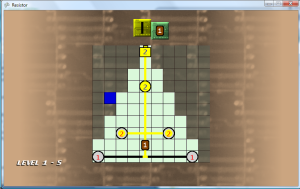I really haven’t done any development for Resistor in over a month, so I decided to go ahead and put it into the Peer Review process on the Microsoft Creator’s Club site. I see it as my way of doing my part in adding to the fine collection of interactive video entertainment titles in the XBox Indie Games marketplace.
With over 400 entries into the Dream Build Play competition, I don’t think I have a chance at being one of the finalists. If the competition was based purely on uniqueness I think my game would fare better. However as in real life, looks do matter and my game is about as plain as it gets.
Overall, I would be thrilled if my game could make $100 on the marketplace, which would equal the original investment that I made for the Creator’s Club membership. Unfortunately, I’ve heard that most XBLIGs don’t make anything, so my goal is probably a bit of a stretch.
Below are the changes I made to the game after putting it through playtest a few weeks ago.
Tutorial System
Tutorial tips were added to teach new players the rules of the games. These tips should not display as long as the player is doing well in the game. The tutorial tip system keeps track of which tutorial tips the player has seen, and it doesn’t display a tip that the player has already seen. However, once the player quits the game the tip flags are reset. A tip is displayed if the player falls to the B rank in any of the three categories. Also, if the player doesn’t use the appropriate resistor and gets a Game Over, then a tip will display when the level is started again stating that resistors should be used to reduce the flow value.
More Graphical Improvements
Made the spinning light sprite display while the LEDs are filling, using the scale parameter.
The rank letters at the end of the stage now zoom into position.
Changed the A, B, and C rank colors to use lighter shades of blue, green, and red. The status icons in the lower right portion of the screen now change with their respective rank values. I also modified the real time rank value of the luminosity category, so that it calculates the rank based upon the maximum possible luminosity of activated LEDs (instead of all LEDs). This way, the player starts out with an S rank in luminosity and the rank is only lowered if they connect a wire with a lower flow needed by the LED.
Audio Changes
Used Audacity to make the ding sound when an LED is activated lower based on the difference between the maximum flow value and the current flow value. The rank grades at the end of the stages use these modified sounds as well.



